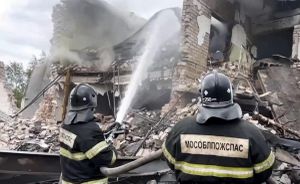Sweden faced its most tragic day yet when at least ten people were killed during a shooting at the Campus Risbergska educational center for adults located in Örebro, around 200 kilometers west of Stockholm. The incident, described as the deadliest school shooting in Sweden’s history, has sent shockwaves across the nation.
According to police reports, the shooting unfolded around 1:00 PM local time on February 4, 2023, during normal class hours. Eyewitnesses recounted the chaos as shots rang out, leading to screams of panic among the students and teachers. Maria Pegado, one of the teachers present, recalled the harrowing moment when she realized the severity of the attack: "I saw people carrying the wounded out, first one and then another, and then I understood what was really happening." This testimony captures the fear experienced at the moment of the incident.
Social media and news updates initially reported about five injured individuals, but figures quickly escalated as emergency services responded to the scene. Local hospitals were put on high alert for incoming casualties. By the afternoon, authorities confirmed the death toll had risen to at least ten, with several more people injured. Many of those affected were adults; the center largely served students over 20 years old, including migrants enrolling for language and professional courses.
"Today we witnessed brutal and deadly violence against completely innocent people," stated Prime Minister Ulf Kristersson, who called the event unprecedented for the nation. Describing it as "a painful day for the country," he expressed his condolences to the victims' families. The Prime Minister, along with Justice Minister Gunnar Strömmer, emphasized the need for meaningful dialogue about weapons control and school safety.
Law enforcement authorities determined the shooter was a 35-year-old man equipped with automatic weapons. He was reported dead at the scene after engaging with police, though initial reports suggested he may have been hospitalized as well. Investigators confirmed the shooter was not previously known to law enforcement and had no reported affiliations with organized crime. While they continue to explore motives, they have ruled out terrorism as the motive behind this incident.
Eyewitness descriptions painted the shooter as wearing a mask when he entered the educational complex and opened fire. Reports from waiting students indicated their escape was narrowly timed: they fled to nearby cafes and restaurants for shelter. One account described hearing five quick bursts of gunfire, adding to the harrowing atmosphere of fear and confusion.
The attack has raised questions about safety measures within schools and the growing trend of mass shootings globally. Sweden, which has prided itself on its relatively low crime rates, sees this tragic event as jolting evidence of the changing realities surrounding gun violence. Pundits and officials are now debating gun laws and potential preventative actions to stave off future occurrences.
This incident has been characterized as the most significant school shooting ever recorded in Sweden. Since 2010, violence related to schools has claimed ten lives across several incidents nationwide; the last major incident occurred when a young gunman, motivated by racist ideologies, killed both adults and students.
The Swedish government is under significant pressure to address the underlying issues surrounding gun violence and to bolster protections for educational institutions. With countless families torn apart by this tragedy, there is also growing unrest among citizens who demand accountable leadership and reformed policies concerning firearm access.
Emergency crews and police continued to investigate the scene for hours following the shooting, ensuring no additional threats remained. Authorities say they are treating the case as attempted murder, arson, and serious firearm-related offenses. They are eager to clarify the nature of the emergency and bring some form of closure to affected families.
A strong police presence remains aroundÖrebro, and citizens have been advised to stay indoors for their safety, underscoring the community’s shaken sense of security. Officials are assuring residents there is no immediate risk of additional attacks, allowing some normalcy to creep back as schools prepare to resume their regular schedules.
This incident will inevitably redefine discussions surrounding public safety, especially within educational environments across Sweden. The government faces the difficult task of charting a path forward as communities come together to heal from this unprecedented loss. The need for reflection and proactive steps is more pressing than ever as the nation grapples with the impact of such devastating violence.



